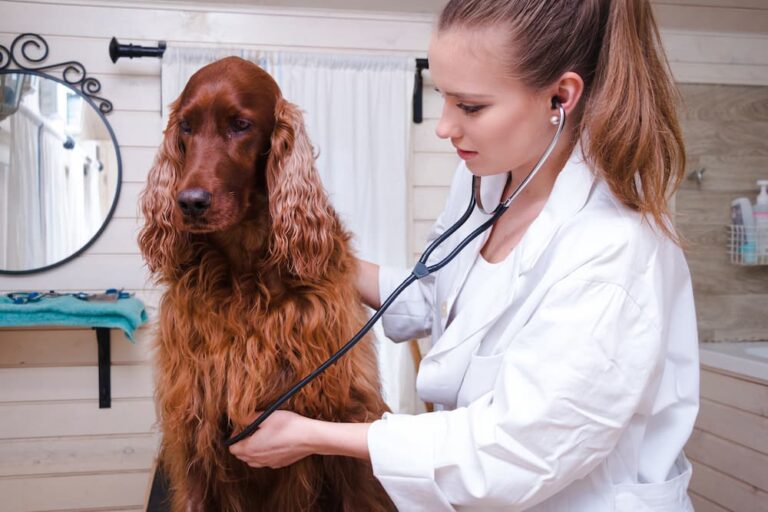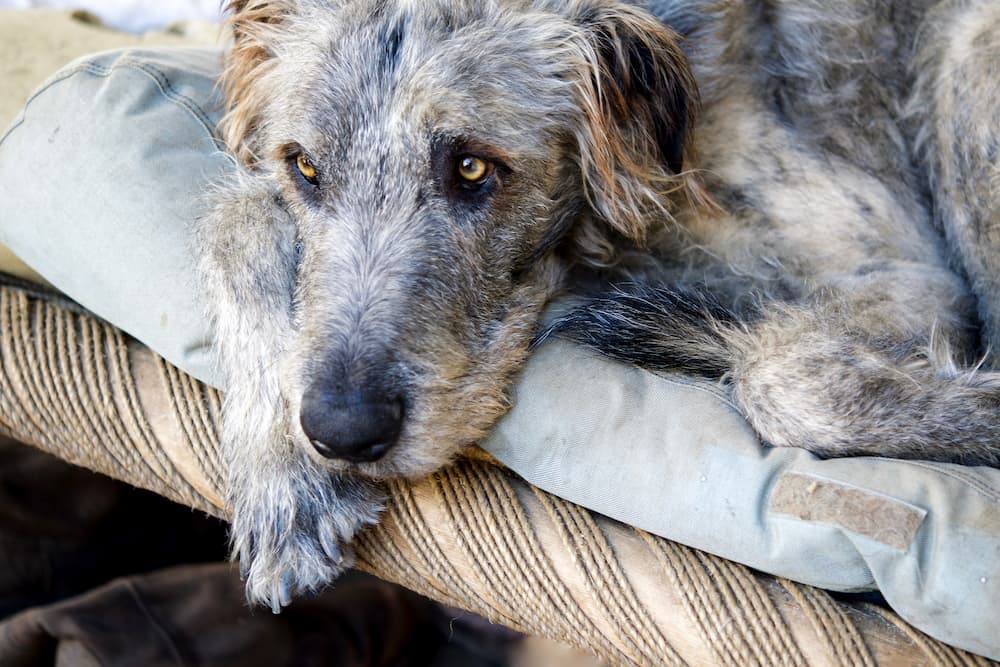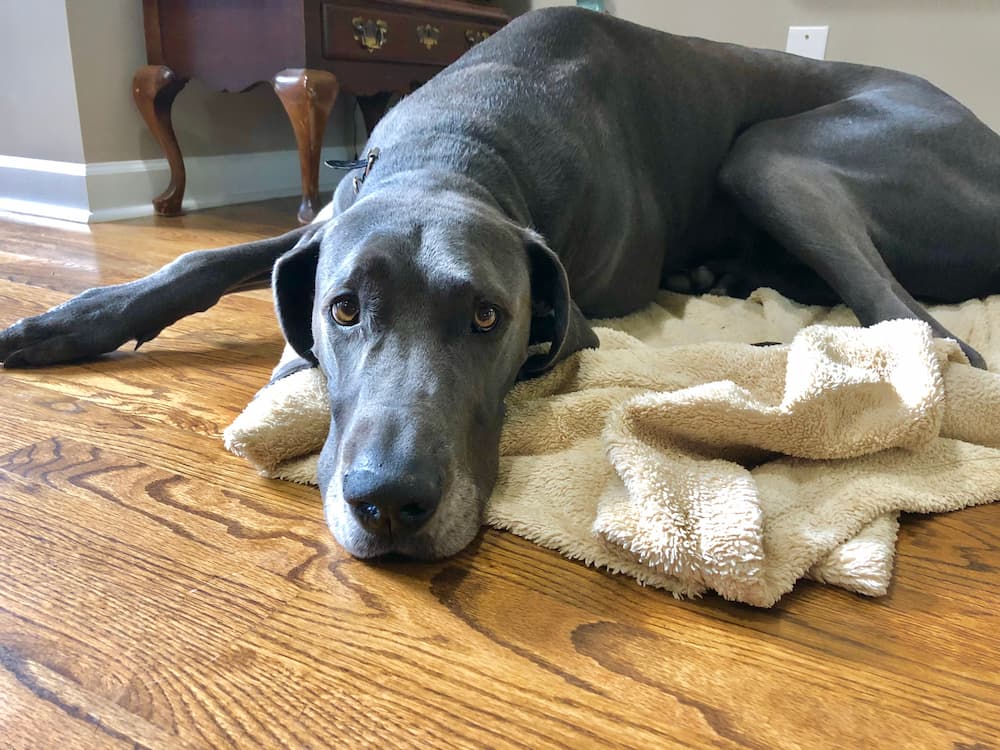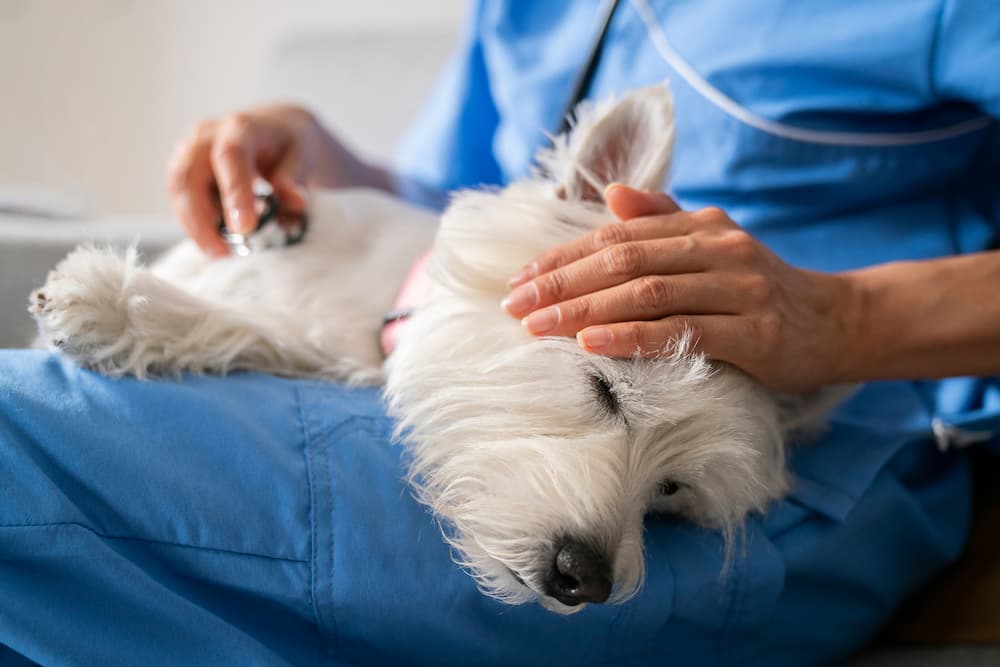10 Dog Breeds Prone to Bloat (GDV)

Have you ever read or heard the phrase “dog bloat”? Bloat in dogs is a life-threatening, fast-moving emergency. Also called gastric dilatation-volvulus (GDV), or sometimes “stomach flip,” bloat occurs when a dog’s stomach fills with gas and sometimes twists. It is an extremely painful condition, and without immediate veterinary treatment, bloat can be fatal.
Research and clinical experience have shown us that certain dog breeds are prone to bloat. These dogs are typically large, deep-chested dog breeds.
If your dog’s breed is at higher risk for developing this condition, it’s important to know the signs and symptoms of bloat and how to minimize your pet’s risk.
The knowledge you gain from reading our list of 10 dog breeds prone to bloat might save your pet’s life, so let’s dive in.
Risk Factors for Bloat in Dogs
So, what makes some dog breeds more prone to bloat than others? Breed matters…a lot. But lifestyle and care can also play a role. The following characteristics are known risk factors for bloat:
- Size and body shape: Large and giant dog breeds with deep, narrow chests are at the highest risk.
- Genetics: Research shows that if a close relative bloated, the dog is at higher risk (1). Another study found that certain genetic lines of Collies, German Shorthaired Pointers, and Great Danes had genetic mutations of genes that influenced stomach motility and tone (2).
- Age: Studies have shown that middle-aged and senior dogs are more likely to develop GDV, and the increased risk becomes more noticeable after age 3 (3, 4).
- Feeding habits: Eating too quickly or eating one giant meal a day can increase risk, research reveals (5). While there have been anecdotal reports that exercising too quickly after a meal can increase the risk of bloat, studies have not supported this (6, 7).
10 Dog Breeds Prone to Bloat

Here are some of the dog breeds most at risk of bloat or stomach twist (GDV):
1. Great Dane
Great Danes top every “dog bloat breeds” list. Their massive size and deep chest are well-known risk factors for veterinarians, so much so that vets routinely recommend preventive gastropexy surgery when they’re young.
2. German Shepherd
German Shepherds aren’t quite as large as Danes, but their body type (deep, narrow chest) and active lifestyle make them one of the dog breeds prone to bloat.
3. Boxer
Bloat in Boxer dogs is well documented. Their deep chest makes them vulnerable, and many Boxers tend to gulp food and air quickly when they eat, which doesn’t help.
4. Large Breed Labradoodle and Goldendoodle
While not an officially recognized AKC dog breed, Labradoodles and Goldendoodles are popular enough to be included on this list. If you have any kind of large breed Doodle with a deep chest, then they are at risk for this condition.
5. Irish Wolfhound
Irish Wolfhounds are big, thin, and have big, deep chests. All of this puts them in the high-risk category.
6. Standard Poodle
Elegant and tall, Standard Poodles are classic deep-chested dog stomach flip candidates. Body shape is the main factor here.
7. Weimaraner
Athletic and narrow-bodied, Weimaraners consistently show up in peer-reviewed studies about dog breeds prone to bloat.
8. Collie
Collies are also among the dog breeds prone to bloat due to genetics and body shape.
9. German Shorthaired Pointer
The long, lean build of Pointers puts them in the higher-risk category for bloat.
10. Irish Setter
Irish Setters are not only on the list of dog breeds prone to bloat — some studies also suggest these dogs may have a heritable risk for bloat (8).
Keep in mind that this list is not exhaustive. While bloat in big dogs is much more common, it can also happen in small and medium-sized dogs. Bloat in small dogs is rare, but not impossible. Dachshunds and Basset Hounds, though smaller, still have deep chests and are occasionally affected.
Care Tips for Dog Breeds Prone to Bloat

If your dog’s breed is on this list (or your dog has a similar build), here’s how you can reduce their risk of bloat:
Feed your dog smaller, more frequent meals: Skip the “one meal a day” approach. Two to three smaller meals are safer.
Slow your dog’s eating down: Use food puzzles, slow-feeder bowls, or scatter food on a cookie tray to prevent gulping kibble whole, which is a known risk factor for bloat.
Skip raised bowls: Research shows elevated dog bowls can actually increase the risk of GDV in at-risk breeds (5).
No post-meal zoomies: While there are no studies to support the risk between exercise and bloat, it is still better to be safe than sorry. Wait at least an hour before and after meals before letting your dog run or play hard.
Manage your dog’s anxiety: Stressed or anxious dogs pant and swallow more air. If anxiety is a problem in your dog, talk to your vet about safe calming strategies.
Be able to identify the signs of bloat: Restless behavior combined with retching without vomiting, drooling, panting due to pain, loss of appetite, and a swollen belly are classic bloat symptoms. If you see these symptoms in your dog, don’t wait; take your dog to an emergency vet immediately.
Be proactive: For established high-risk breeds, ask your vet about gastropexy surgery, which can prevent bloat. This procedure can be done at the same time as a spay or neuter surgery. It is also a good idea to have pet insurance or an emergency fund on hand in case the worst happens. Treatment for bloat surgery typically costs thousands, but it’s life-saving.
Bottom Line

While any dog can experience bloat, some dog breeds are at higher risk of bloat than others, especially large, deep-chested dog breeds. If you share your life with one of these breeds, prevention and quick action are everything. Slow their eating, manage their stress, and take action if you notice suspicious symptoms. Knowing what dogs are prone to bloat (and how to help them) can literally be the difference between life and death.
References
- Inherited and Predisposing Factors in the Development of Gastric Dilatation Volvulus in Dogs (Bell, Jerold S., 2014)
- Identification of Genetic Susceptibility Factors Associated with Canine Gastric Dilatation-Volvulus (Piras, I. S. et al., 2020)
- Analysis of risk factors for gastric dilatation and dilatation-volvulus in dogs” (Glickman et al., 1994, J Am Vet Med Assoc)
- Glickman, Lawrence T.; Glickman, Nita W.; Schellenberg, Diana B.; Raghavan, Malathi; Lee, Tana L. “Incidence of and breed-related risk factors for gastric dilatation-volvulus in dogs.” Journal of the American Veterinary Medical Association. Vol 216, No. 1 (2000): pp. 40-45.
- Glickman LT, et al. “Non-dietary risk factors for gastric dilatation-volvulus in large and giant breed dogs” (J Am Vet Med Assoc, 2000)
- Pipan, M., Brown, D. C., Battaglia, C. L., Otto, C. M. (2012). An Internet-based survey of risk factors for surgical gastric dilatation-volvulus in dogs. Journal of the American Veterinary Medical Association (JAVMA), 240(12), 1456-1462.
- Theyse, L. F. H., van de Brom, W. E., & van Sluijs, F. J. (1998). Small size of food particles and age as risk factors for gastric dilatation-volvulus in Great Danes. Veterinary Record, 143(2), 48-50.
- Influence of thoracic conformation and genetics on the risk of gastric dilatation-volvulus in Irish setters” (Schellenberg D., Yi Q., Glickman N.W., Glickman L.T.; J Am Anim Hosp Assoc, 1998)









